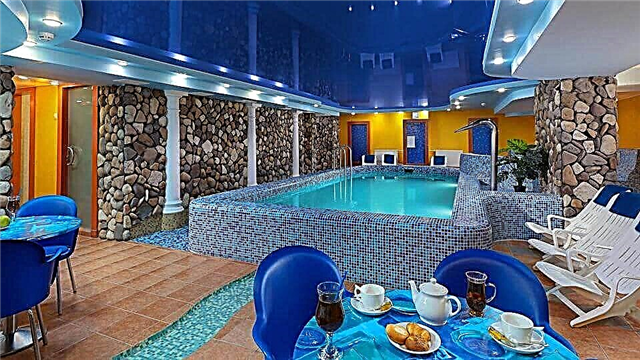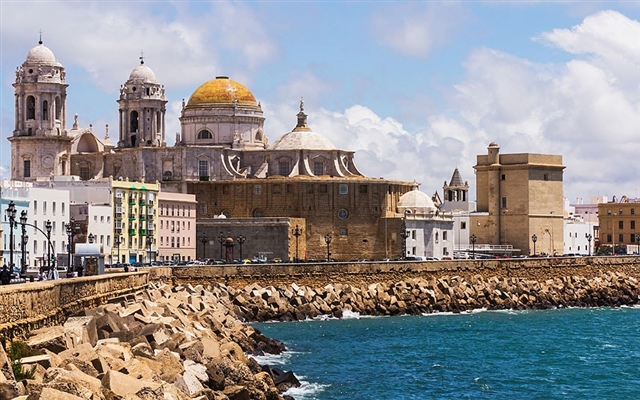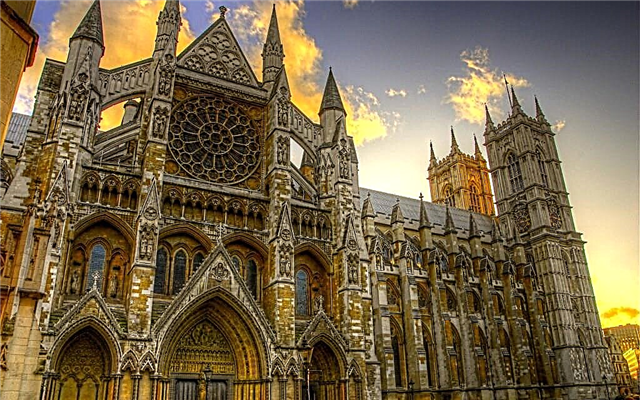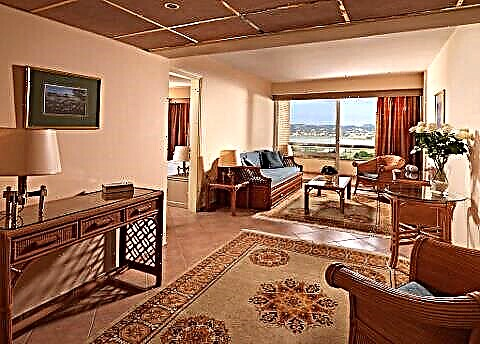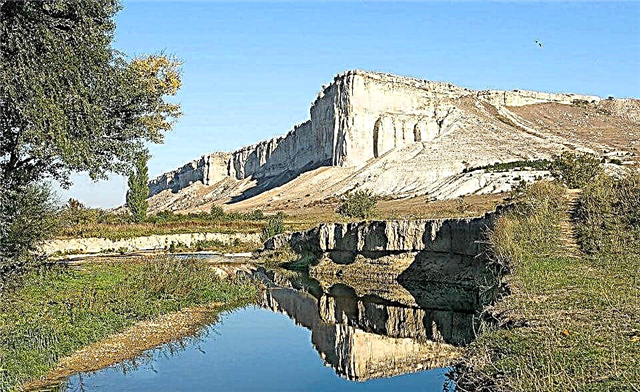Crimea is a pearl on the resort map of Russia. Vacationers often spend their holidays limiting themselves to the hotel-beach-hotel route and evening entertainment. It must be remembered that the land of Taurida is unusually rich in sights that amaze the imagination of even sophisticated travelers. Therefore, while on vacation, a guest of a seaside resort town should know that the most beautiful places in Crimea are waiting for him. Local excursion services offer many routes. These are traditional popular places such as Swallow's Nest, Vorontsov Palace and others. Along with this, it will be interesting to visit the Kizil-Koba cave, marvel at the beauty of the Chokrak, Panagia, Koyash lakes and visit other not-so-famous tourism sites. Along with this, many hiking trips are organized. You have to see all this yourself in order to absorb the full range of impressions from the beauties of Crimea.
Sunny Valley

The village, located near the sea coast (4 km), is surrounded by picturesque mountain peaks bearing the Crimean Tatar names: Parsu-Kaya, Eptigen and Tokluk-Syrt. Previously, the area was full of archaeological monuments - burial grounds, the remains of temple structures and defensive structures. The temple of the Holy Prophet Elijah has survived to this day. It rises in the center of the village.
The village of Solnechnaya Dolina is unique in its climatic conditions. Thanks to the natural protection of the mountain peaks, there are almost always clear blue skies and bright sun. Since ancient times, the indigenous grape varieties that grew in this area have become as a result of processing wines with medicinal properties. In small doses, the miracle cure quickly healed severe wounds, restored the strength and morale of the soldiers.
The winery brought glory to the famous village, the pride of which is the red dessert wine "Black Doctor". Only in the Sun Valley does the grape variety of the same name ripen, retaining all its useful qualities to the fullest. It is always full of tourists who seek to learn the "secrets" of obtaining a healing drink, taste it and purchase several bottles of dark red balsam.
You can get here with an excursion group from Sudak. It is also possible to go to the winery with an individual guide, leaving your personal vehicles in the parking lot.
Baydarskaya valley

This is the most beautiful and largest valley on the peninsula. Its name sounds in the Crimean Tatar language, like Baidar uva. The intermountain basin occupies an area in the southwestern part of the peninsula. Some of the best tourist voyages to the valley begin in Alushta and 5 km from the Balaklava highway from Sevastopol. Professional guides choose a path on a relatively flat area without sharp descents and steep ascents. Therefore, parents can take their children with them.
Travelers will go to the shore of the Chernorechensky reservoir, which supplies Sevastopol with drinking water. Having entered the highest point of the Baydar Valley - the Biyuk-Karmazy cliff-cape, adults and children will be fascinated by the delightful panorama of the Emerald Canyon. Near the ruins of the medieval fortress Sardzhik-Isar, tourists will hear from the guide an interesting history of the emergence of the fortification, and what battles took place here.
The group will walk along the paths along the rushing streams of water of the Chernaya River along the mountain rapids, ending in picturesque waterfalls. On a cozy meadow surrounded by mountain ranges, a halt will be made, where the participants of the walk will be fed a hearty lunch. After that, everyone will go to the Yusuf-Koba cave, where at one time archaeologists discovered the site of ancient people. At the end of the voyage, it will be interesting to see the underground missile command post of the Cold War era.
Bird home

The Swallow's Nest attracts tourists with its romantic appearance and unusual location. The structure, erected on the edge of a cliff, seems to float in the air, which creates a fantastic picture of a flying small fortress against the backdrop of the vast expanse of the Black Sea water area.
Before the castle took on its final appearance, the structure underwent several reincarnations from a wooden wing to a solid stone building. At one time, the building served as a dacha, later a reading room was arranged in the castle, more recently there was an Italian restaurant. Currently, the castle is only accessible for external inspection. The premises are closed to the public due to restoration work, which should be completed by the end of 2020.
You can visit the attraction yourself. From the Yalta bus station to the Swallow's Nest, you can get to the village of Gaspra by bus number 102. The most convenient way is to take part in the excursion. A professional guide will accompany a group of tourists by car to the castle and back, along the way providing a lot of useful information.
Vorontsov Palace

The palace complex in Alupka is one of the most famous palaces of the South Bank. It was built in the middle of the 19th century for Count Vorontsov, Governor-General of Novorossiya. The castle structure was erected by the British architect Blore, who had never been to the peninsula.
The central accent of the architectural wonder is the southern terrace with a wide staircase and figures of sleeping lions. Before the revolution, three generations of the Vorontsov family managed to live in the palace. The estate was nationalized in 1921. The castle complex was given the status of a museum. During the war, the German invaders completely plundered it. During the Yalta Conference, the British mission was located here, headed by Prime Minister Churchill.
Since the times of the USSR, the palace has attracted filmmakers. Many feature films were shot here, such as "Hamlet", "An Ordinary Miracle", "Scarlet Sails" and others. The backyard area is a luxurious garden and park economy, which was created by the painstaking work of gardeners for more than thirty years.
Massandra Palace

One of the most beautiful villas on the peninsula is the Massandra Palace. The building is recognized as a monument to the perfection of palace architecture of the 19th century and is under state protection. At the end of the century before last, the unfinished building due to the death of Vorontsov was bought by the Emperor of Russia Alexander III. A year later, the death of the tsar entailed the transfer of the Crimean real estate to Nicholas II. During his reign, the palace acquired its present appearance.
Experts estimate the architectural style of the mansion as an example of a Renaissance building. The three-storey villa is covered with a multi-pitched roof with several peaks, and the curly window openings of the mansards create a fabulous image of the facade. Ornate staircases, open galleries, terraces and balconies add a special charm to the exterior of the palace.
The landscaped area is eighty years older than the palace. The park complex occupies 42 hectares, where cozy paths are laid between juniper bushes, cedars, pines, cypresses and flower beds. The easiest way to get there will be from Yalta by trolleybus or bus. You need to get off at the Upper Massandra stop. The descent to the attraction will take 10 minutes.
Livadia Palace

The outstanding architect Krasnov made a huge contribution to the creation of the unique appearance of the Crimea. It was according to his project that the magnificent Livadia Palace was built for the royal family of the Romanovs. The light festive style of the Italian Renaissance combined the majesty of the palace with the soft image of a country villa.Inkerman limestone was used as a building material for the walls.
The building has 58 living rooms and 116 premises for various purposes. The façade is accentuated by the sumptuous main entrance with columns of bluish-white Carrara marble. On both sides of the massive oak door, there are huge dark green Ural jasper vases.
It is especially loved by foreign tourists and everyone who is fond of the historical events of the Second World War. It was in this palace building that the famous Yalta conference was held. A favorite place for tourists for photo shoots is the area in the courtyard, on which a sculptural composition of three figures sitting in armchairs, the heads of the anti-Hitler coalition: Churchill, Roosevelt and Stalin, is installed.
Karadag reserve

Have
an amazing natural area - the Karadag reserve is located not far from Feodosia on the territory of the Kara-Dag volcanic massif with an area of about 3 thousand hectares. The reserve acquired its status in 1979. The unique beauty of the reserve's landscapes attracts both numerous groups of tourists and independent travelers.
However, the entrance to the territory of the reserve is allowed to tourists only as part of organized groups. Exotic views of Kara-Dag are associated with fantasy alien landscapes. This phenomenon can be easily explained by the thousand-year "work" of the sun, wind and sea waves over volcanic formations. So, the symbol of the reserve is recognized as a rock-arch, rising directly from the depths of the sea, the name of which sounds like Shaitn-Kapu, which means the Devil's Mouth.
Other bizarre rock formations received no less sonorous names: Dragon, Ivan the robber, King and others. During the existence of the reserve, 125 species of animals living on the slopes of the mountain range, and about 80 species of flora, listed in the Red Book, have been preserved and avoided extinction.
Nikitsky Botanical Garden

This is one of the oldest open-air museums of living flora. As a research institution, the plant nursery was founded in 1811. Nikitsky Botanical Garden is one of the diamonds in the crown of the sights of the South Coast. On the Alushta - Sevastopol highway, in front of Yalta in the village of Nikita, travelers are greeted by a rotunda crowned with an inscription in gold letters - "Nikitsky Botanical Garden".
Founded by Alexander I, the garden has collected a huge living collection of plants brought from almost all over the world throughout its existence. Walking along the alleys and paths among the amazing representatives of the flora is a real pleasure for the guests of the park complex. More than 2,800 species of trees, grasses, flowers and shrubs grow here.
A professional connoisseur will lead an organized group of tourists to the most interesting places of the park, tell the history of its creation along the way, tell about the intricacies of the gardener's profession and the achievements of the scientific department of the botanical garden. At the exit in the store you can buy seeds and seedlings of rare plants. Sales consultants will advise what is better to buy and for what growing conditions the planting material is suitable.
Uchan-Su waterfall

The waterfall is a delightful sight of the falling stream of crystal clear water from a height of 100 meters. Located on the mountain slope of Mount Ai-Petri, it attracts the attention of a large number of tourists. The natural attraction is located near Yalta in the mountains at an altitude of 390 meters above sea level.
A winding and rather steep serpentine road leads to the waterfall. You can get here by bus from Yalta as part of an organized group together with a professional expert of the region. From the observation deck on the upper cascade, a reinforced concrete box is visible, at the top of which there is a bronze figure of an eagle with spread wings. While at the waterfall, sightseers will hear from the accompanying ancient legends and tales associated with Uchan-Su.
Jur-Jur waterfall

The water slope is located at an altitude of about 4800 meters above sea level. Dzhur-Dzhur is the name of the waterfall, the pronunciation of which resembles the sound of bubbling water. You can reach it through the village of Malorechenskoye, turning towards the village of Generalskoye. After 8 kilometers of the way, guests will be greeted by the Dzhur-Dzhur waterfall. You can come here with your car and leave it in a comfortable parking lot.
From here you have to walk up the mountain. However, not everyone can walk 1 kilometer of a mountain road under the scorching sun. Enterprising local residents organized the rise of people to the final point of the route in an SUV. This trip will remain in the memory of travelers for a long time as a dizzying quest.
On the way there are beeches with enormous trunks, hornbeams, oaks, hazel and dogwood. In these places, at one time, Soviet directors filmed many episodes for feature films-fairy tales. Untrained citizens should not try to swim under the jets of falling water. The water temperature does not exceed 110 C.
White rock (Ak-Kaya)

Among the mountains, the mountain formation that bears Ak-Kaya stands out with special beauty, which in Russian means White Rock. Both names are legitimate and legitimate. The rock is nothing more than a sharp cliff of a plateau of light beige, formed as a result of prehistoric natural disasters.
The geological phenomenon is located in the valley of the Bilyuk-Karasu river. A steep rock mass hangs over the village of the same name. Its highest point rises above the valley at an altitude of 325 meters. A closer look shows that the walls of the rock are dotted with depressions and filled with numerous rapids. Standing at the foot of Ak-Kai, a person feels the grandeur of the greatness of the mountain formation.
The unusual view of the snow-white mountain has attracted and continues to attract filmmakers from Russia and other countries. The majestic snow-white rock can be seen in such legendary films as "The Leader of the Redskins", "The Headless Horseman", "The Man from Boulevard des Capuchins" and others. You can drive to the White Rock from the side of the city of Belogorsk. After 4 kilometers, tourists will be greeted by the village of Belaya Skala. There is a dirt road leading to the top of the mountain, which is better to climb on an off-road vehicle, especially in autumn and winter.
Marble cave

Taurida is rich in various sights, including the gifts of the underworld. On the peninsula at one time, many caves of fabulous beauty were found and explored. The most mysterious and mysterious of them is the Marble Cave. Thanks to the geological processes that have taken place, the dungeon is a real miracle of nature, which has gained worldwide fame.
The cave was discovered in 1987 by members of the local speleological club on the lower plateau of the Chatyr-Dag mountain range. In terms of its volume and length, the karst cavity, located at an altitude of 900 meters above sea level, occupies a leading position among similar objects in Europe. Visitors to the cave can walk about 1 kilometer underground, descending to a depth of 60 meters.
Highlights along the route paint fantastic pictures of the fairytale interiors of magical castles. For vivid impressions and bursts of unforgettable emotions streams of tourists rush here. It should be noted that the logistics of a phenomenal object is still imperfect. If the road from the Simferopol highway to the village of Mramornoye has a civilized asphalt look, then after it you will have to move along a dirt road to the cave itself. It is better to carry out a road trip in this direction on an off-road vehicle.
Kizil-Koba cave

The Red Cave is one of the largest karst cavities not only in Crimea, but throughout Eastern Europe.According to the suggestions of speleologists, the Kizil-Koba cave was formed as a result of gigantic geological cataclysms more than two and a half million years ago on the slope of the Dolgorukovskaya Yayla not far from Simferopol.
The name of the Kizil-Koba cave (Red Cave) is directly related to the reddish-red color of its inner surfaces. This is due to the presence of iron oxide in the karst rock. The exploration of the dungeon is still ongoing. Today, the explored length of the cavity is 21 kilometers.
Kizil-Koba is located in six levels. Currently, an underground route of 500 meters is available for visitors. In the cave, the constant air temperature is 90 C. The temperature difference compared to the external indicator can sometimes be about 25 degrees, so travelers should be aware of this and take warm clothes and shoes with them in advance.
Mangup-Kale

In the Bakhchisarai region, there is an amazing attraction - the cave city of Mangup-Kale. In the center of the southwestern highlands rises Mount Baba-Dag (Father Horus), the southern slopes of which are a solid rock wall, and on the northern side it is cut by deep gorges. The peak Mangup (the second name of the mountain) is located near Balaklava in the area of the village of Khoja-Sala at an altitude of 580 meters above sea level.
On the flat top of the mountain in the Middle Ages, the city of Feodoro was located - the capital of ancient Gothic, which owned all this mountainous region. Later, the fortified city began to be called Mangup-Kale. The citadel itself is a narrow strip of land with a fortress wall between the cliffs. In the middle of the wall, a 3-storey building was built, which housed offices for the ruler, command staff, barracks, an arsenal, a food warehouse and a well 20 meters deep.
Deep caves were discovered here, in which traces of ancient people were found in them. Scientists attribute the cave city to the distant eras of the Taurus period. The best way to get to Mangup-Kale is from Bakhchisarai or Sevastopol. The route runs in the direction of the village of Kholmovka, bypassing the villages of Zalesnoye and Ternovka on both sides of the road. All the way there are direction signs to Mangup-Kale.
Chokrak lake

Lake Chokrak is located a few kilometers from Kerch. The reservoir is separated from the Sea of Azov by a narrow strip of land. It has long been believed that its mud has healing properties. It is used to treat the musculoskeletal system and the nervous system. It is this feature of the lake that attracts crowds of tourists every year in the summer season. Their black bodies, covered with mud, are visible on the lake shore from afar.
Most of the "newcomers" settle in apartments in the village of Kurortnoye. At the same time, many tents can be seen on the shore. If in campsites the sanitary situation is maintained at an acceptable level, then in the “wild” it needs the best. It should be noted that local authorities are striving to bring the resort area into a civilized state, and over time, the issues of unsanitary conditions will disappear.
Lake Panagia

An amazingly beautiful small lake is located in the Panagia tract of the same name in the north of the picturesque village of Zelenogorye (between Alushta and Sudak). The area is located at an altitude of 290 meters above sea level. The time of the geological origin of the reservoir is attributed to the end of the ice age. Its water area resembles a triangle in its shape.
The maximum height of the water level is set in April. At this time, the depth of the lake can exceed 10 meters. During the summer season, due to the heat, the reservoir becomes very shallow, exposing the banks for several meters. The only source of water replenishment is the Kushen-Uzen mountain river and underground springs.
The tract, together with the lake, is considered an unofficial protected area. Swimming in Panagia is allowed, but it is strictly forbidden to burn fires on the shore. Resorts prefer not to put up tents, but to rent an apartment in the village of Zelenogorye.
Koyashskoe lake

To the south of Kerch, on the Black Sea coast, there is an amazingly beautiful reservoir - Koyashskoye Lake. A real miracle of nature is separated from the Black Sea by a narrow strip of land. For hundreds of years, Koyash attracted the peoples living nearby with the unusual pink color of the water. The lake is especially beautiful at sunset. The water takes on a juicy red hue. Tens of thousands of tourists visit the lake every year.
Koyash is the salty lake of the peninsula. The maximum mineralization of water occurs from the second half of July and lasts until mid-August. At this time, the density of the saline solution in the reservoir reaches 390 grams per liter of water. Popular rumor ascribes a divine origin to the lake.
This is facilitated by the water area of the reservoir, which during the day draws fantastic pictures that conjure up various mystical images. During dry days, the lake takes on a more intense red color. The culprit for the pale pink to bright red color is a special microscopic algae. In the process of photosynthesis, microorganisms secrete a red pigment that stains the lake.
Mount Demerdzhi

A huge mountain formation with the sonorous name Demerdzhi literally hangs over Alushta. The mountain, due to its mystical appearance, is covered with many legends and beliefs. An organized walk to its top is one of the peninsula's most romantic and breathtaking tourist routes. Travelers will be amazed by the mystical Valley of Ghosts, delighted with the beauty of the landscapes opening up in front of them.
Throughout the route, a professional guide will tell the stories of the local peoples who lived during the reign of the Byzantine Empire and the period of the Crimean Khanate. After passing the Valley of Ghosts, the group will climb to the top of South Demerdzhi.
It will be interesting for adults and children to see the fantastic looking stone pillars with pebble inclusions, testifying to their marine origin. While in Solnechnaya Polyana, travelers will see the legendary tree, on the branches of which the famous comedy troika in the film "Prisoner of the Caucasus" was seated.
Leaving Solnechnaya Polyana, the participants of the route will go to the highest observation deck crowning Mount Alenta. Here you can have an amazing photo session against the backdrop of stunning mountain landscapes. The apotheosis of the trip will be admiring the sunset against the backdrop of fantastic clouds from the top of Demerdzhi.
Mount Ayu-Dag

Ayu-dag is better known as the Bear Mountain, which means the same thing in two languages. A huge rock plunges its southern slope into the Black Sea near the Partenit resort. The height of the Bear Mountain reaches 573 meters. Administratively, the rock belongs to the forestry of Gurzuf. The mountain appeared many millions of years ago as a result of volcanic activity of the bowels.
Discovered traces of the first settlements of people on Ayu-Dag, scientists date back to the tenth century BC. Archaeological excavations are not interrupted here. Their results bring artifacts in the form of various primitive tools, stone arrowheads and spears. The remains of a later settlement are usually attributed to the Taurus.
In the VI century, the temple of the Apostles Peter and Paul was built here, which was destroyed by the Ottoman Empire. It is best to climb to the top of Ayu-Dag as part of an organized group of tourists with a professional guide. There are two paths to go upstairs, one of them starts in Partenit, and the other path leaves the village of Lavrovoe.
Both routes subsequently merge into one line, going exactly along the ridge of the rock. An informative walk, lasting 2.5 - 3 hours, is accompanied by interesting stories from the guide. There are no sharp ups and downs on the way, which disposes children to participate in the voyage.
Mount Ai-Petri

This is one of the main attractions of the South Shore.It can be clearly seen from Yalta and nearby resorts - Massandra, Livadia, Oreanda and other villages. We can say that the rock dominates the entire southern coast of Taurida. In fact, the visible part of Mount Ai-Petri from below is nothing more than a cliff of a large plateau, which is located at an altitude of 1230 meters above sea level.
There are large and small caves, waterfalls. Also, after the summit, the Grand Canyon begins. You can get to the mountain in three ways - these are two highways from Yalta and Bakhchisarai and a cable car from Miskhor. The best travel option is to climb Ai-Petri in the cable car cabin, and go down by car. Getting up in a carriage for up to 40 people is a delightful adventure.
The cabin covers a 3-kilometer path upward in 15 minutes, flying over a picturesque mountain slope. The apotheosis of the trip will be the grandiose panorama of Yalta, nearby villages and the Black Sea, which will appear at the top for the guests of Ai-Petri.
Tarkhankut Peninsula

The Tarkhankut Peninsula is the westernmost part of the Crimea. The cape stretches out into the sea with two sheer cliffs - large (8.2 km.) And small (1.6 km.) Atlesha. The area attracts numerous amateur tourists with its pristine nature. There are no enterprises or large settlements here. There is no need to talk about a developed tourist infrastructure, it simply does not exist here.
The coastal water area is replete with underwater sharp reefs, so it is not suitable for navigation. The absence of any vegetation on the peninsula is compensated by the picturesque coastal cliffs. A natural small reservoir, with its shape reminiscent of a symbolic heart, was named the "Chalice of Love". The pool is fed with water by a natural tunnel dug underground by sea waves.
Diving enthusiasts come here in the summer season. The crystal clear water allows scuba divers to fully enjoy the beauty of the underwater world. People pitch tents and lead a "wild" lifestyle, enjoying the silence of the chaste nature of Tarkhankut.
Grand canyon

A huge depression in the center of the southern part of the peninsula adjoins Mount Ai-Petri. The territory of the giant depression was named the Grand Canyon. Here you can find numerous mountain rivers and lakes, walk along an extreme mountain road, plunge into the bath of youth, swim under the streams of a waterfall.
And finally, heal the body with clean mountain air, clearing the lungs of city smog. The tourist service offers to take part in scenic excursions along the Grand Canyon. The walks last 2.5 hours, during which the groups will cover 8.4 kilometers of the path without sharp ascents and steep descents.
So parents can take their children on an exciting journey without any fear. The territory of the Grand Canyon is open to everyone who wants to visit the picturesque basin. Since 2016, the paid entrance has been canceled, the only thing is that voluntary donations can be collected for various charitable events.
Chersonesos Tauride

Chersonesus Tauric is a monument of world importance, included in the UNESCO list. Here, at the crossroads of ancient civilizations, ancient Russian Christianity was born. The ancient city itself became the forerunner of modern Sevastopol. Archaeological excavations are carried out here all the time. Every year expeditions delight with new finds. The most valuable artifacts are kept in the Hermitage.
The central attraction of Russian Orthodoxy is the active Vladimir Cathedral, erected on the site of the basilica, where the baptism was performed over Prince Vladimir. Nearby you can see a huge Mist Bell, cast from captured Turkish cannons, suspended between two pillars. Chersonesos Tauride is an open-air museum.
You can walk along its streets for an infinitely long time, admiring the preserved and restored towers, columns, an inn, a smithy, a winery and a basilica. However, it is rather difficult for a visitor to independently understand the life of the ancient people. The best solution is to join a guided tour led by a museum worker. The Historical Reserve is open from 8:30 am to 7:00 pm daily, seven days a week from April to October. During the rest of the year, the work schedule is reduced from 9:00 to 17:30.
Cape Chameleon

Cape Chameleon juts out into the Black Sea as a narrow arrow of land a few kilometers from the village of Koktebel. With its bend, the cape with the right bank forms a bay called Tikhaya. This place is known for the fact that many young people come here in the summer season, who prefer a "wild" vacation.
The peninsula was formed from the accumulation of ash ejected by the long extinct volcano Karadag. Due to the constant erosion of clayey rocks, the cape is cut with cracks, so you need to walk along it with extreme caution. Placed plates remind of this. The peninsula got its name for its resemblance to a lizard with a crest on its back.
In addition to this, the phenomenon can serve as a result of which the cape during daylight hours can change color from bright orange to purple. Scientists explain the phenomenon by the special order of occurrence of clay shales in the cape massif. They reflect sunlight differently depending on the change in the angle of incidence of the rays.
Cape Fiolent

Cape Fiolent is located 10 kilometers from Balaklava, if you go in the direction of Sevastopol. The prominent part of the land in the sea was formed as a result of the accumulation of lava and ash from the most powerful volcanic eruptions many millions of years ago. Bizarre forms of solidified lava, preserved to this day, create a fantastic landscape of the area. A huge number of caves and grottoes, crystal clear water and oxygenated sea breeze make the cape one of the most unique places in Taurida.
To embrace all the beauty of Fiolent, you can use the car provided by the driver-guide. An individual excursion is designed for 4 people, during which the participants of the voyage will not only drive along the cape, but also hear stories about the birth of Christian culture, visit Diana's grotto, visit the cave city of Kachi-Kalion, the Beaded Temple and the Church of St. Sophia.

